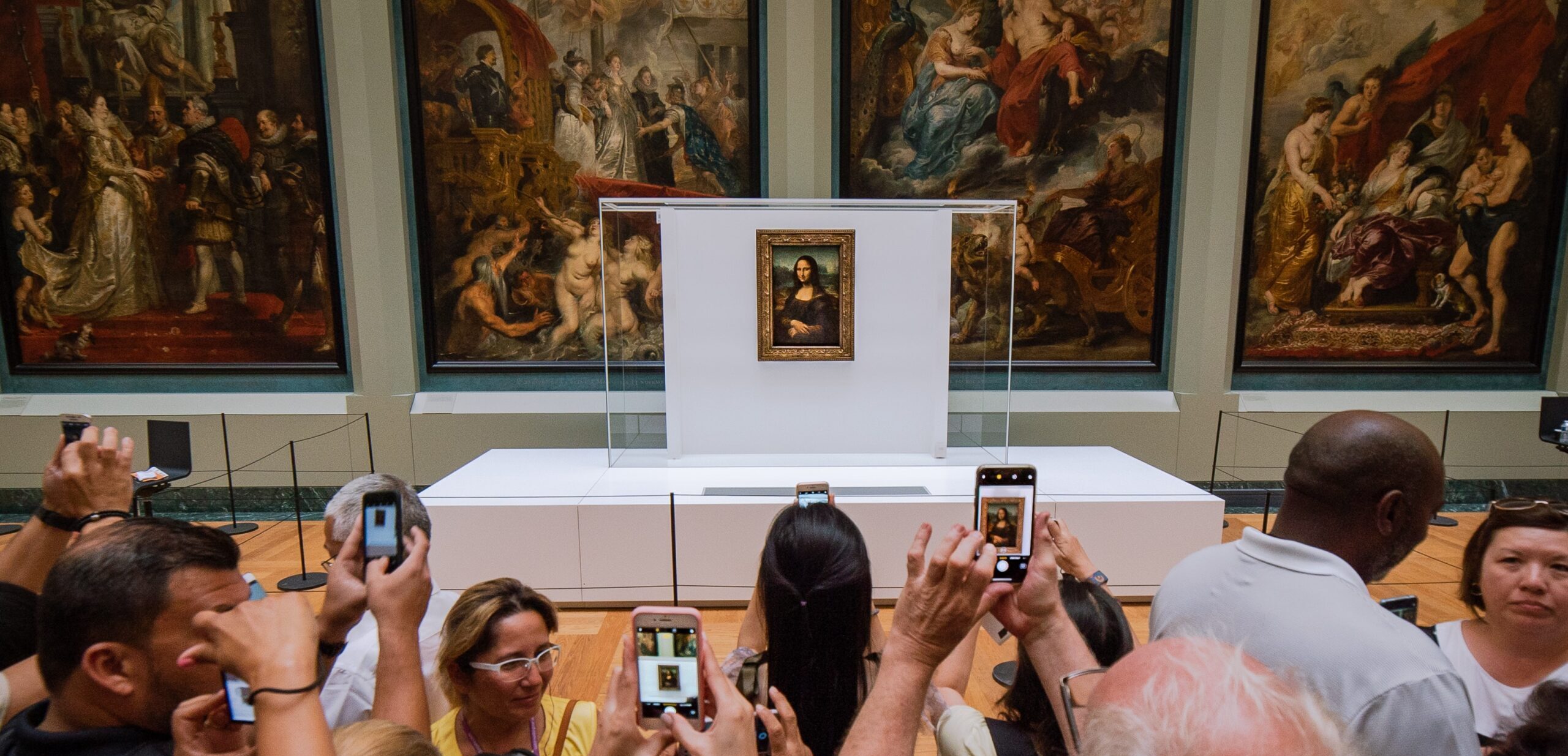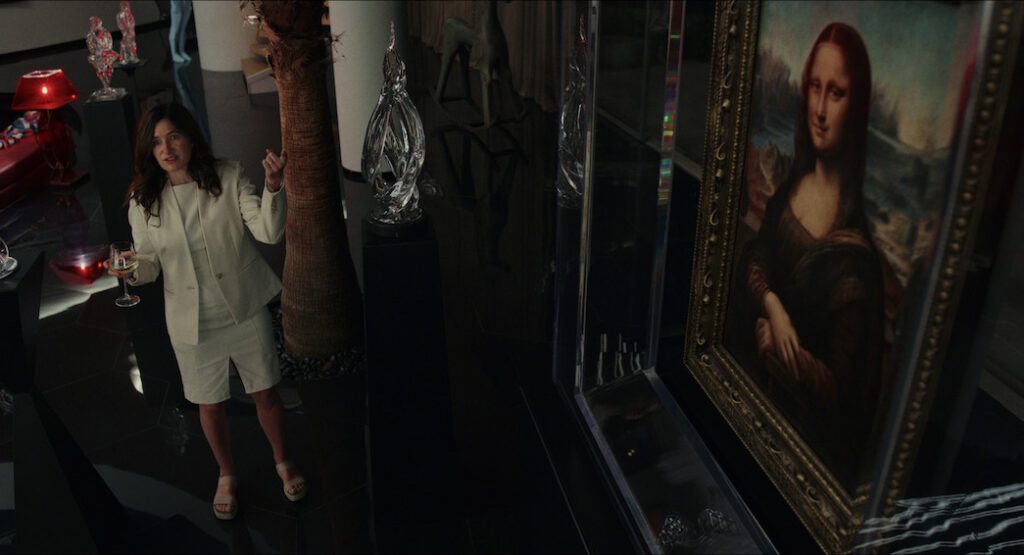
What Role Did Art Serve in Glass Onion: A Knives Out Mystery?
Fine art has commonly taken the supporting role in the backgrounds of TV and film, but in Rian Johnson’s latest celebrity-packed murder mystery, Glass Onion, the artwork takes center stage.
At first glance, the movie focuses on a colorful friend group that orbits an Elon Musk-like billionaire, Miles Bron, portrayed by Edward Norton.
Inside Bron’s private glass menagerie lies his incredible art collection, which Kathryn Hahn’s character Claire calls “the Tate Modern.” The artwork was impressive, and the eager aficionado could appreciate every artist’s cameo throughout the duration of the film.
However, those with a trained eye would be able to spot that these are not really works but often “inspired by” masterpieces, courtesy of the flawless set design.
What’s Glass Onion All About?

Miles Bron is a fictional tech billionaire who invites a group of his old acquaintances to join him for a murder mystery weekend at his $450 million Grecian estate, where the film takes place. (The stunning home, for interested parties, is actually on the market.) All the guests, with the exception of detective Benoit Blanc (Daniel Craig), know Miles personally.
After everyone gathers at the island and is inoculated against COVID-19, they assemble in the house’s atrium, where they stand in the grand collection space that serves as the main backdrop of the story.
The paintings and sculptures watch silently as banter, secrets and lies are exchanged, and an attempted faux murder takes place. This is soon followed by a very real murder and the group grapples with one another to solve the crime.
We won’t spoil the dramatic twists and reveals that give Glass Onion its many layers.
Instead, let’s focus on the artwork.
The Deeper Meaning of the Mona Lisa in Glass Onion

Much of the purpose of production and set design is to encapsulate the tone of the plot and the character’s personalities.
When we first enter the pseudo lair of Miles Bron, the opulence of his lifestyle is aggressively demonstrated by the sheer amount of art present. But what takes opulence to utter ridiculousness is the attendance of one single artwork: the Mona Lisa, so prominently displayed and discussed that she earned her own character poster for the film.
Having the Mona Lisa, a painting that is so famous its true monetary value cannot be determined, encased in a transparent frame that you control in your glass house shaped like an onion only speaks to the level of wealth Bron exudes.
To take this further, the Mona Lisa is the only artwork that doesn’t have to compete for attention against a gallery wall that looked as if a hoarder curated it. She stands alone against a large window, obstructing the view, giving the viewer no choice but to acknowledge it (if that wasn’t difficult to avoid) and furthermore, acknowledge Bron’s status and wealth in order to offer a “small loan to the country of France.”
In the film, the painting, like all the other art alongside it, is quite literally the backdrop to a crime scene. One museum’s crown jewel becomes a rich man’s silent witness.
The painting is simply just a prop to flaunt his wealth. Its significance isn’t given much attention with the exception that Bron harks on an incorrect art historical factoid, claiming Leonardo da Vinci “invented a technique for brushstrokes that leaves no lines.” That technique is called sfumato, and anyone that has read or studied Giorgio Vasari’s The Lives of the Artists knows that the skill was attributed to the Flemish painters, not Leonardo.
In the final act of the film — spoiler alert — Janelle Monáe, as Bron’s whip-smart antagonist, sets the Mona Lisa on fire. This leads to the entire gallery atrium catching fire and all the artwork included, however the main focus is on the Mona Lisa.
It’s interesting that our main heroine is the one who sets fire to the Mona Lisa. At a time when the relative value of art versus human needs is often discussed in regards to climate change protests, Glass Onion takes a strong stand: That the most iconic works of the Old Masters are only as immortal and important as the suffering humans around them can allow.
What’s more, the painting worth the most money gets the greatest attention in Glass Onion, enacting the same misguided art historical dynamic Miles Bron inhabits as the clumsy, thoughtless collector.
What Other Art Was Featured in Glass Onion?

One of the joys of watching a movie is the opportunity to spot and appreciate the various works of art that appear on screen, whether they be paintings, sculptures, or other forms of visual media.
In the case of Glass Onion, it was almost exhausting to identify and name all of the artworks that shared the screen with the actors, let alone to follow the plotline of the film while squinting into the background to decipher on whether that was a Shara Hughes or 1980 David Hockney (no surprise, it was a Hockney).
The main living and dining room atrium, where the majority of the film’s action takes place, serves as Bron’s personal museum floor, with walls covered in blue chip art.
Watching the movie scene by scene allows us to do a closer reading of the art and its significance.
The Hockney, the Basquiat and the Upside Down Rothko
When the group is seated in Bron’s 70s inspired sunken living room, there are three paintings in the frame.
One is Nichols Canyon by David Hockney, a 1980 painting that portrays the picturesque Los Angeles neighborhood in colorful Hockney fashion. It’s considered one of his greatest masterpieces and by far the most significant landscape painting he ever created. However, what really sets the painting apart is that it was last sold in 2020 for a whopping $41 million with buyers’ premium.
On the other side of the frame is In This Case by the iconic Jean-Michel Basquiat. Completed in 1983, it was formerly part of the private collection of Valentino co-founder Giancarlo Giammeti. The painting was last sold in 2021 for $93.1 million.
Both of the paintings are seen flanking an unquestionable Number 207 (Red over dark blue on dark grey) by Mark Rothko. Mark Rothko created this piece in 1961, and like most of his works, it follows a format of stacked rectangular forms painted on top of other colors.
Now, this painting has no record of being sold at public auction so there’s a lot of speculation around the true value of the artwork. Still, Rothkos are increasingly rare, and a great addition to any collection.
Sadly, Miles Bron does this painting no justice in his Glass Onion. The Rothko painting can be seen hanging upside down, demonstrating his superficial appreciation for art and lack of knowledge or care for his own collection, aside from the value.
The Never Before Seen
There was a lot of art displayed in the main atrium and throughout the property, making the whole estate a masterpiece in its own right.
While some, like the paintings described above, are replicas of actual paintings that exist within history, the collection for the most part was comprised of works that borrowed creative influence from actual artists, but no matter how hard you looked, could never be found in their oeuvre.
By creating artworks that shared styles, motifs and color patterns to famous artists, it promotes the image Miles Bron has of an exclusive and rare collection of works.
Some of the paintings that graced the silver screen were recreations of a series of portraits that looked to be completed by Francis Bacon. They can be seen in the background when Blanc is uncovering his theory of the crime. It only added more tension as the three grotesque faces loomed above the group, as they struggled to cope and understand what had just occurred.
Another, less centrally framed piece, was a cycloptic creature that surely was an homage to Phillip Guston. This work can be seen during the dinner scene, behind Kate Hudson’s character.
There was also a featured piece of a woman crying in the entry way of the atrium, which anyone knows is synonymous with pop artist Roy Lichtenstein.
Outside the Atrium
There was also famous artworks almost hiding in plain sight outside the atrium. In one scene when all the characters were seated on a grand porch, there was a subtle Simone Leigh bust in the background.
In the gardens surrounding the compound was a replica of a Fernando Bottero sculpture — and let us not forget the Banksy Love Is In The Air glass dock. Introducing the art aspect into the film with perhaps the most gaudy example of them all. Not only does this piece have an exceptional irony in replicating the imagery of the anti-consumerist graffiti artist, it’s not even functional as we later learn.
The sheer size and array of works in the film’s fake art collection could be described as ostentatious and a bit too much. But that was Rian Johnson’s goal.
What Role Did the Art Serve In Glass Onion
Similar to the Mona Lisa, the borderline ridiculous collection in the film was to remark on the character of Miles Bron as an ostentatious yet modern billionaire.
The collection borders on the line of gauche and bad taste, not because of the art selected but how it was displayed. While the collection of masterpieces seems to demonstrate appreciation and intelligence, the lack of care given to their display points in the other direction. It seemed Bron used it as a means to elevate his already high status to impress his already bought posse. Miles finds his meaning in what he owns, not what he contributes.
His obsession with holding titles that don’t belong to him guides Glass Onion’s entire arc and mystery, and the art collection in the background of all the scenes is meant to serve as a constant reminder of this.
There is no doubt that the Miles Bron collector exists in real life, however I’m more pleased that while the film Glass Onion touches on themes of greed and exploitation, it also got the public interested in many masterpieces of contemporary art.
Start Building Your Own Art Collection Through Masterworks
Want to build a unique art collection that expresses your taste without the Bron financing?
You can begin building your own masterpiece collection online with Masterworks.
Masterworks is an art investment platform that lets you invest in fractional shares of investment-grade art.
With prices starting at $20 per share, investing in your favorite artworks has never been easier.
Here’s a quick overview of how the platform works:
- The research team identifies which artists’ markets have potential.
- The acquisitions team then locates a piece they believe could appreciate in value and purchases it.
- Masterworks files an offering with the Securities and Exchange Commission (SEC) to securitize the artwork.
- After you’ve invested in shares, all you need to do is wait. Masterworks can hold the painting for 3–10 years. If the piece is sold at a profit, you’ll receive pro rata returns after fees are subtracted (1.5% annual management fees plus 20% of the profit from the sale of the artwork).
- Alternatively, you can opt to sell your shares on the secondary market.
Get started by completing Masterworks’ membership application.
See important Reg A disclosures: Masterworks.com/cd